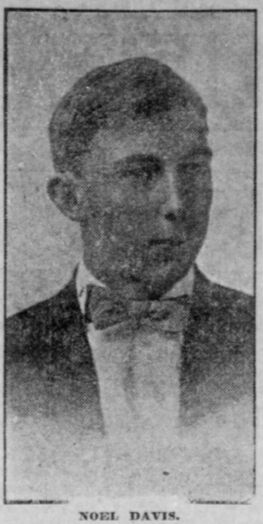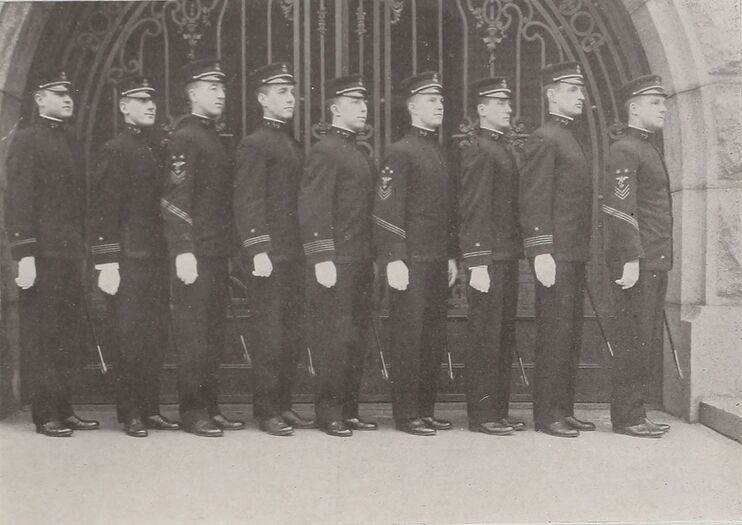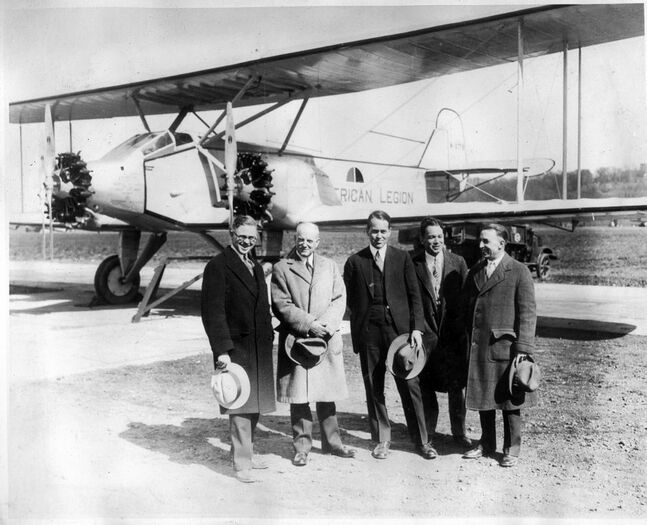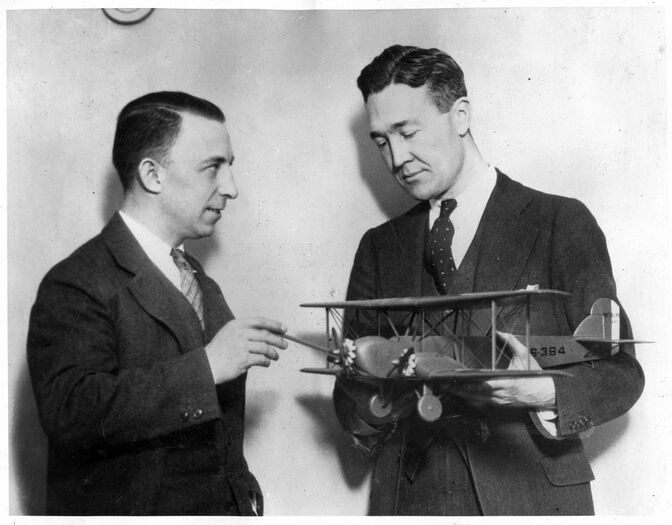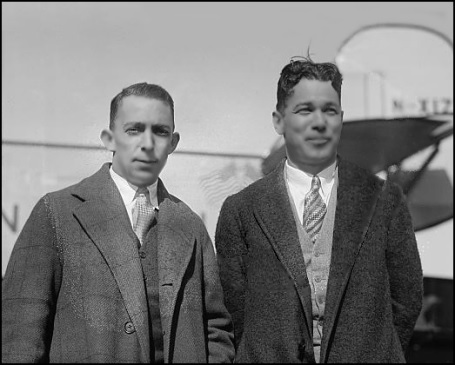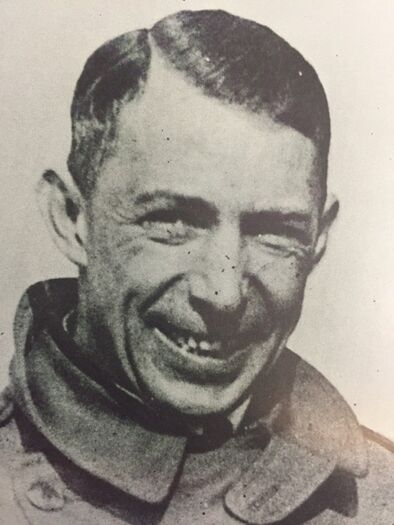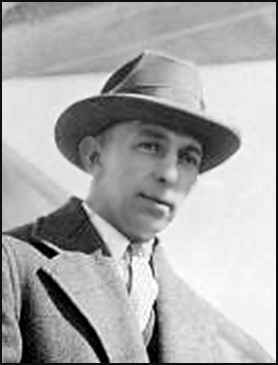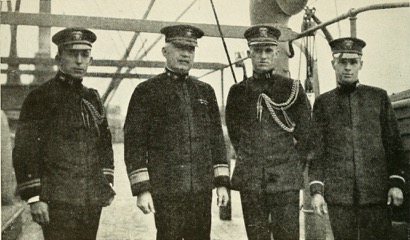NOEL DAVIS, LCDR, USNR
Noel Davis '14
Lucky Bag
From the 1914 Lucky Bag:
Noel Davis
Salt Lake City, Utah
"Noel" "Percy" "Cinq"
MAN, this sturdy little giant can do anything and do it exceptionally well. In the roles of inventive genius, social climber, chesty athlete, and savoir, he has been equally successful. Energy radiates from him. His determination and enthusiasm are irresistible, and whether it is dazzling the foe in a lacrosse game or hypnotizing a Prof in the class room, Noel is a wonder.
Now it is seldom that you find such a paragon with many friends yet there is not a more popular man in the class. His manner is always friendly and that winning smile would make the Sphinx sit up and wag its tail. He is on good terms with every one about the Academy from mess boys to Superintendent.
There is a good bit more deviltry to his credit than should be included in the past of a five-striper but no one has ever ragged him and only his pals are the wiser. If there is anything exciting afoot, keep near the heels of this young whirlwind and you will have some interesting experiences. During the day he oscillates all over the place and if you really want to see him, look anywhere but in his room.
As a servant of the class he has acted in many capacities. First of all as Capt. of the Class Basketball team. As Chairman of the Ring Committee he proved himself a willing martyr and an able diplomat.
A better balanced man than Noel, or one possessed of as many fine qualities which we admire would be hard to imagine. Five minutes after you meet him he is sure to be your next choice for President.
Star (4,3,2); Five Stripes (1); Chairman Class Ring Committee; Lucky Bag Staff; Captain Class Basketball (4,3,2,1); Class Lacrosse (4); LNT (3,2)
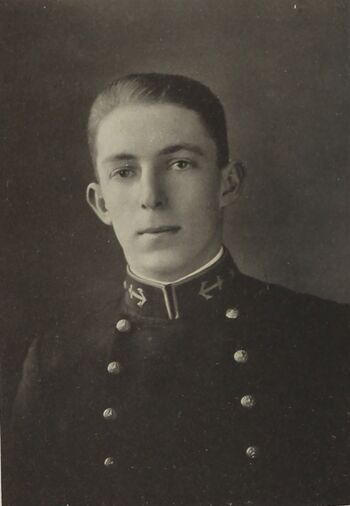
Noel Davis
Salt Lake City, Utah
"Noel" "Percy" "Cinq"
MAN, this sturdy little giant can do anything and do it exceptionally well. In the roles of inventive genius, social climber, chesty athlete, and savoir, he has been equally successful. Energy radiates from him. His determination and enthusiasm are irresistible, and whether it is dazzling the foe in a lacrosse game or hypnotizing a Prof in the class room, Noel is a wonder.
Now it is seldom that you find such a paragon with many friends yet there is not a more popular man in the class. His manner is always friendly and that winning smile would make the Sphinx sit up and wag its tail. He is on good terms with every one about the Academy from mess boys to Superintendent.
There is a good bit more deviltry to his credit than should be included in the past of a five-striper but no one has ever ragged him and only his pals are the wiser. If there is anything exciting afoot, keep near the heels of this young whirlwind and you will have some interesting experiences. During the day he oscillates all over the place and if you really want to see him, look anywhere but in his room.
As a servant of the class he has acted in many capacities. First of all as Capt. of the Class Basketball team. As Chairman of the Ring Committee he proved himself a willing martyr and an able diplomat.
A better balanced man than Noel, or one possessed of as many fine qualities which we admire would be hard to imagine. Five minutes after you meet him he is sure to be your next choice for President.
Star (4,3,2); Five Stripes (1); Chairman Class Ring Committee; Lucky Bag Staff; Captain Class Basketball (4,3,2,1); Class Lacrosse (4); LNT (3,2)
Loss
Noel was lost on April 26, 1927 when the plane he was piloting, American Legion crashed in Virginia. He and his copilot, Stanton Wooster '17, were on their final test flight before attempting to cross the Atlantic Ocean for the first time. Charles Lindbergh accomplished the feat several weeks later.
Other Information
From researcher Kathy Franz:
Noel graduated from Latter-day Saints high school in the spring of 1909. For two days, his mother kept the secret that he was appointed to the Naval Academy by Congressman Joseph Howell. She had it announced when he received his high school diploma.
On June 12, 1910, Noel’s mother was bidding him goodbye at the depot when her house caught on fire. Noel’s sister Bessie was home and alerted neighbors and the fire department. The neighbors removed most of the valuable furniture from the house. The fire was caused by defective electric wires.
On July, 4, 1912, Noel’s brother Harry died at the Wandamere motordrome. Harry was going 60 miles per hour on his motorcycle in the preliminary race when the red flag came out. He lost control and his body was hurled into an electric light pole; his motorcycle crashed into a crowded section of the grandstand. Several people were injured, two critically. His mother was there and witnessed the accident.
In September 1913, after the summer cruise on the battleship Illinois, Noel was appointed cadet commander, a high distinction. At graduation from the Naval Academy in June 1914, he received the sword for first honor in practical and theoretical ordnance in gunnery. He was then assigned to the cruiser California.
In August 1915, Noel spoke to the Second Ward’s parents’ class in Salt Lake on the subject “Our National Situation.”
In December that year, Noel was ordered to report for instruction in the fine details of optics and compass work at the Sperry Gyroscopic Compass works in New York City and later at the Bausch & Lomb Optical works at Rochester, New York. After his instruction, he assisted in the installation of the delicate instruments into the dreadnaught Nevada at Fore River Iron Works yards at Quincy, Massachusetts.
In February 1920, Noel attended a dinner in his honor given by his mother and another dinner given by local post 44 of the American Legion.
At the time, he was writing a history of the North Sea barrage during World War I. He commanded a squadron of mine sweepers in the North sea which helped lay 250 miles of mines and after the war destroyed them. The article was printed with many photographs and illustrations in the February 1920 issue of the National Geographic magazine (pp 103-133.) In part, he wrote: “This barrage was an impregnable wall stretching from Scotland to Norway . . . It was a magnificent achievement, typically American, and demanding the concentrated efforts of many of the largest manufactories in the United States to produce the complicated parts which make a mine.
“In these mines there was contained more than 21,000,000 pounds of TNT, extending over an area of 6000 square miles. We sowed the wild oats, and after the signing of the armistice they had to be reaped, and the American navy removed them.”
Noel married Mary Elizabeth Merritt on June 17, 1924, in Pensacola, Florida. Their son Noel, Jr., was born in 1925.
Noel’s father Garwood was a boat builder who died in 1904. His parents had divorced, and his mother later married Joseph Price.
On September 1927, Col. Charles A. Lindbergh flew four times over Noel’s mother in Oakley, Idaho. He dropped a message as a tribute to Noel and his mother which was tacked upon the wall by the post office door. She wrote a thank you to Edward Hale who had arranged for the Lindbergh flight.
Harry F. Guggenheim, who was a friend of Noel’s, established the Noel Davis trophy to be awarded annually for competitive work in the naval reserve.
From Together We Served:
A case of "it might have been". Noel Davis, a Naval Aviator who is buried in the John Merritt Family plot in St. John's Historic Cemetery, was killed on his final test flight while attempting to be the first to fly non-stop across the Atlantic Ocean in April 1927. He was married to Mary Elizabeth Merritt, oldest daughter of John A. and Mary Turner Merritt, both members of prominent Pensacola families.
Born in Salt Lake City on Christmas Day in 1891, Davis kiddingly told friends in later years that he thought he was going to school in Indianapolis where he could look forward to some good auto racing but learned the Navy had Annapolis in mind instead.
Noel Davis graduated third in his class from the U.S. Naval Academy in 1914. As aide to Admiral Joseph Strauss, commander of U.S. mine-laying forces, he was assigned to Inverness, Scotland to supervise laying an estimated 56,000 mines between Scotland and Norway. At the end of World War I, he was ordered to duty removing the mines and after some difficulty, developed a plan using a suggestion by a radio operator to disarm the mines before attempting to remove them from the sea. He then authored several books for the Navy Department related to the laying and recovery of mines.
Applying for aviation training, Davis arrived in Pensacola in the early 1920's, and was designated Naval Aviator No. 2944 on August 11, 1921. While still a flight student he became Officer-in Charge of the Ground School at Pensacola in June 1921 and authored the first manual for that school. Resigning his regular commission in July 1922 to attend Harvard Law School he accepted a commission in the Naval Reserve and became commanding officer of the first station for Naval Aviation Reserves in Squantum, Massachusetts, later writing textbooks for training reserve pilots. While in Boston, he was co-inventor of the first aerial sextant used in flight navigation.
On April 25, 1927, the Pensacola Journal's banner headline proclaimed "Pensacola to Paris Flight Planned". His wife, dubbed by her father as "Kitten", was scheduled to make the flight as radio operator onboard the plane named "The American Legion" but decided the risk was too great when thinking about their young son. As fate would have it, she was not in the plane when it lost speed on takeoff with a full load of fuel needed to cross the Atlantic Ocean. The plane landed in a marsh near Langley Field, Virginia but nosed into the swamp, trapping both Davis and his co-pilot, Stanton Wooster, in the cockpit.
Less than a month after Noel Davis was buried in St. John's Cemetery, Charles Lindbergh made his successful crossing in the "Spirit of St. Louis". Admiral Richard E. Byrd, who had become the first man to fly over the North Pole a year earlier, said he was "shocked beyond expression" at the loss of the two pilots who "have given their lives to the progress of aviation".
In recognition of his considerable contributions to Naval Aviation, the Schools Command Building (633) at NAS Pensacola has been dedicated to his memory and the annual trophy awarded to the outstanding Naval Air Reserve Squadron is named in his honor. Noel Davis was buried in St. John's Cemetery 1 North Section 5.
From the Richmond Times-Dispatch, April 27, 1927: Speaking over radio station WOR in Newark, New Jersey, Lieutenant Commander Richard E. Byrd characterized Davis as “the most able and brilliant lieutenant-commander in the naval aviation” and Wooster as “the most able of lieutenants.”
Commander Byrd concluded his eulogy with the glowing tribute: “They have gone West – and we may be sure that they went unafraid. Their loss is inestimable but their brave spirit will accelerate the aviation of our country.”
Those Willing to Dare
From Naval Aviation News in March-April 1999, via Naval History and Heritage Command:
Monday, 25 April 1927, Langley Field, Va.: Several reporters gathered at Langley Field this morning are questioning two Navy pilots about their preparations for the first nonstop air crossing of the Atlantic Ocean, from New York to Paris. But the winds are unsatisfactory for today's test flight, allowing the two Naval Aviators a few minutes to answer some questions. Commander Noel Davis and Lieutenant Stanton Wooster are standing in front of their aircraft, christened American Legion. Cdr. Davis, the pilot, gives an update on the project.
"We are almost ready to get away now, but there is no hurry about the trip. We want to have everything in our favor and I think the May full moon will give us favorable weather."
He continues with a description of the American Legion. "I have never piloted a better plane. Some of us had feared that when the machine was loaded to capacity, as she will be when we start on our long flight, a large field would be necessary for her to get up, [but] the machine rises in less space than is required for some smaller planes. It is the best mechanical bird I have ever seen, and I believe we will make the flight to Paris with few difficulties."
A reporter directs a question to Cdr. Davis: "Do you really believe these big flying machines, manufactured in this country, are capable ..."
Davis interrupts and looks directly at the reporter. "A few years ago we held all the aviation records. We have lost nearly all of them. We make as good planes and motors as any country in the world, and we have as good pilots. I want to see some prestige in the air return to our country."
Later, another reporter asks, "Are you ready?"
No two aviators are better prepared.
A graduate of the U.S. Naval Academy, Noel Davis is described by his classmates as a "sturdy little giant who can do anything, exceptionally well." Davis went to NAS Pensacola, Fla., in 1920, and became a Naval Aviator in August 1921. He later headed the Naval Reserve Flying Headquarters in Washington, D.C. In his spare time he solved a persistent aircraft navigation problem by creating the Davis aircraft sextant.The first one to be manufactured is to be used on his nonstop flight across the Atlantic. The Navy has ordered several of them, confident in Davis' assessment of its functionality.
In flying, having total confidence in your copilot is paramount. Lt. Stanton Wooster meets Davis' high standards; some say he's the top Naval Aviator at flying large, heavy airplanes. Wooster actually pilots the airplane more than Davis, who is frequently busy with instrumentation data and calculations.
Wooster attended Yale University and graduated from the Naval Academy in 1917. He was later assigned to NAS Pensacola for flight training, qualifying as a Naval Aviator in June 1920. Since his assignment to the Bureau of Aeronautics in September 1924, he has assisted Davis with planning the Atlantic crossing. Wooster has some ideas he believes will improve the operation of flying machines. For example, he supports the use of metal propellers, with which the American Legion is equipped. Many experts continue to doubt the capabilities of metal propellers versus the proven wooden designs.
Both pilots supervised the construction of the airplane, a Keystone Pathfinder, at Bristol, Penn., and have made all of the test flights together. The Pathfinder at Langley Field has been modified with several tanks totaling 1,500 gallons, five times the usual capacity. The fueled airplane weighs in at 16,000 pounds. Some say it's a flying fuel tank. Today, the airplane will fly at its maximum weight for the first time.
The dimensions of the aircraft are also impressive: 45 feet long, with a wing span of 67 feet. The American Legion is equipped with three Wright J-5 Whirlwind engines, rated at 220 horsepower each one in the nose and one on the upper surface of each lower wing. If one of the engines fails during flight, the airplane will be able to continue flying.
Tuesday, 26 April: Everything is "go." When the ground crew reports to Langley Field, they find the three large propellers turning. Wooster is at the controls. Everything is operating perfectly, and the morning weather is ideal for flying.
Davis meets with ground crew members for some last-minute instructions. He directs the mechanics to go down the field, spaced far apart so they can measure the take off. This is it: the final test flight! After returning to Langley Field, the next flight of the American Legion will be to New York for final preparations and then the prize the first nonstop air crossing of the Atlantic Ocean.
A few minutes later, Davis joins Wooster in the cockpit. With the pre-flight checks completed, Davis orders the brakes to be released. The American Legion begins to tremble as Wooster takes the airplane to the end of the runway, where he idles the engines and prepares for takeoff.
As the plane begins to move down the runway, the tail begins to lift as the speed increases, but the wheels are still on the ground. A few individuals have pocket watches and are timing the takeoff. Ten ... 20... 30 seconds ... the airplane is not lifting off. And, then, finally — wheels off! The aircraft has required a quarter mile of runway to become airborne, and it just misses touching a thicket of pine trees at the end of the runway by only a few feet. From the dirigible hangar the ground crew and officers watch as Wooster keeps the airplane close to the ground. Moments later, the American Legion is over the waters of Back River on the northern boundary of Langley Field.
Suddenly, there's a problem. Both are looking at the instrumentation panel, engines and wing surfaces. Wooster adjusts the controls and turns the American Legion into the northwest wind. This maneuver results in a limited increase in altitude, which is around 50 feet - far less than normal at this point in flight. On the present course, the American Legion won't be able to clear the approaching tree line. Davis decides to circle back toward Langley Field, but as the plane banks right it loses the benefit of the head wind. Almost immediately, the airplane side slips and decreases in altitude. It's obvious that the flight will have to be aborted. Working together, Davis and Wooster bring the airplane under control for an emergency landing in the marshes that border Back River.
Within moments, the aircraft passes over a small section of shore line. The right wheel touches first, then the tail and the fuselage hit. For about 125 feet the plane skids across the marshes, kicking up mud and water. Major damage occurs on impact, especially to the landing gear, engine propellers and port-side wing. The American Legion continues to skid across the marshes until it hits a large pond. When it reaches the other side, the airplane crashes nose down and the center motor is torn from the mounting.
Local Virginia watermen, work ing their fish nets in Back River, witness the crash and stop their work to rush to the aircraft. The area contains leaking aviation fuel, and the engines are smoldering. Disregarding the danger, they know they must provide assistance if there is any chance of saving the pilots.
The watermen retrieve an anchor rope from a nearby boat. Several climb onto the airplane, securing one end of the rope to the tail section. Pulling on the rope in an effort to right the airplane, the rope snaps.
A stronger rope is tried, but it also breaks. They attempt to reach the pilots by digging through the mud, but are unsuccessful. The two aviators are dead.
The bodies of Cdr. Davis and Lt. Wooster are removed from the aircraft by midmorning. Both pilots were found buckled in their seats; they had died from injuries received during the crash. Their bodies are transported to the Langley Field hospital.
Word quickly spreads throughout the world of the crash and the untimely deaths of the pilots. Polar explorer Commander Richard E. Byrd, who is also preparing to be the first to fly nonstop across the Atlantic, issues a statement later in the day. "The deaths of Davis and Wooster came as a distinct shock. We were rooting for each other. I hoped that both would make Paris for the advancement of science. Only several days ago I wrote [Davis] offering what assistance he cared to ask of me, and his last message to me before taking off was to offer some good advice. It was this type of splendid American that aviation has lost. It was this type that makes one feel proud to strive for the same goal. Both Davis and Wooster have given their lives to the science of aviation. They were my old friends. Each was a brilliant, courageous air pioneer. Their loss to aviation is irreparable."
Both aviators are later buried with full military honors, Cdr. Davis in Pensacola and Lt. Wooster in Arlington Cemetery, D.C.
Although others will soon succeed where they have failed, Davis and Wooster nonetheless leave their mark on the early years of Naval Aviation. For future generations, they will represent the spirit of all those pioneering pilots who dared lay their lives on the line to reach for new heights in Naval Aviation.
American Legion Flies New York To Paris In 1927
From American Legion Department of California, by Kevin Burns on February 28, 2022:
In 1927, the race for the Orteig prize became one of the greatest sporting events in all history. People around the world followed every tidbit of news that was reported on it. Often if there was no news, reporters simply made it up to sell newspapers. It was part of the culture of the times. Raymond Orteig, a New York hotel owner from Paris, set the goal of flying non-stop from New York to Paris, or from Paris to New York, with a prize of $25,000. From 1919 to 1925, no one attempted to win this prize. The technical advancements to make it possible just were not there.
Although a number of fliers announced their intent to compete in the race, only two filed applications in 1927 for the New York to Paris contest; Charles Lindbergh and Noel Davis. Others like Richard Byrd and Clarence Chamberlin announced that they would compete and comply with the race rules, but were not interested in the prize money and did not want to be restricted by the requirement of having to register for the prize sixty days before the flight.
Lt. Cdr. Noel Davis was Commander of the Naval Air Reserve under Admiral Moffett. He had gone to the Naval Academy with his copilot, Lt. Stanton “Bob” Wooster, whom was head of the Navy’s Propeller Research Center at Langley Field in southern Virginia. Both of them were excellent aeronautical engineers and as members of the American Legion, they looked to the Legion for support. Davis had two huge tasks ahead of him now; finding a suitable airplane to make the transatlantic trip and to find sponsors to fund the expedition.
He decided upon the Huff-Daland LB-3; an Army heavy bomber plane that had a solid reputation. It was a two-engine biplane with a large machine-gun emplacement in the nose. Davis planed on taking out the machine-gun emplacement and putting in a third Wright Whirlwind engine. The reliable air-cooled radial Whirlwind engine was the technology that finally made the attempt possible with its thrust to weight ratio.
Davis still faced some formidable obstacles; he needed to raise cash quickly, get his publicity arrangements made, and to come up with a name for the airplane. Being a well known veteran of World War I, having set and removed the North Sea Barrage under Admiral Strauss, and being a vocal proponent of military aviation, he turned to the American Legion organization. In 1927 the national convention was to be held back where it originated in Paris, France, on the tenth anniversary of the US entering the Great War. Who better to sponsor the flight of two war veterans who were still active in military aviation?
There was immediate support from the Aeronautics Commission, and at the urging of the chief lobbyist for the American Legion, John Thomas Taylor, Davis wrote to Bowman Elder (who was the Chairman of the American Legion convention to be held in France) and to Howard Savage (the National Commander of the American Legion), whereby Davis conveyed his plans in detail. These letters were accompanied by letters from Porter Adams (President of the National Aeronautic Association, and Chairman of the Aeronautic Committee for the American Legion’s Department of Massachusetts) and Rear Admiral William Moffett (Chief of the Navy’s Bureau of Aeronautics); both urging the American Legion to lend their support to the effort.
Elder, at the national headquarters of the Legion in Indianapolis, promised to bring it before the National Executive Committee (NEC) of the American Legion and to promote the Legion’s support of the effort, and asked for more details. There was a ground-swell of support from the average Legionnaire to many officers in the state and national organizations of the American Legion, but funding such an expedition was breaking new ground and many within the organization were hinting that the National Executive Committee would be cautious in their decision.
They were correct. After the National Commander had made national news at the christening of the airplane as it was named the “American Legion;” the NEC ruled that because they were going for a cash prize, it was a commercial venture that the American Legion could not support. However, they softened the ruling by allowing the airplane to be named “‘The American Legion,’ providing it could be accomplished without obligating Legion funds for the purpose.” If Elder had his way, the Convention Committee would have underwritten the entire expedition by themselves.
By this time, Davis and Wooster found other financial support, and spoke to some of the management of the American Legion Monthly Magazine as a back-up plan. What they came up with was, in the April edition, they would publish an article authored by Davis telling of his plans for the flight. By this time the flight would either be completed or very near completion. In same edition, Davis would run an advertisement whereby for two dollars Legionnaires could send in to buy a post card that was transported on the flight, and it would be sent to them from Paris. The card would urge them to attend the Legion’s great tenth anniversary convention in Paris.
While already on leave from the military, Davis and Wooster decided to perform one last set of tests at Langley Field where Wooster was stationed, before flying to New York. Concerned about the extra thousand pounds of weight they had not calculated for in the airplane, they decided to make a series of ten more take-off flights. By adding extra fuel onboard, it was weight that would dissipate during the flight and insure that they would not run short of fuel just before making it to Paris.
Not sticking to the test plan, the last five hundred pounds was put on the plane for the final test flight. It was too much. The airplane shuddered as it lifted into the air. Unable to lift above the tree at the end of the runway, it banked and soared over the Back River. Caught in ground effect and unable to lift the airplane over the trees on the far bank of the river, Davis and Wooster decided to set the airplane down in the flat tidal marsh. Coming in for a perfect landing, the front wheels suddenly dropped into a hidden drainage ditch and skid nose first into a small pond. With no safety equipment at the time, Davis and Wooster were sitting in wicker seats and didn’t have a chance for survival. A few weeks later, Charles Lindbergh successfully made the flight.
Some weeks after the crash, Harry Guggenheim personally, not acting on behalf of the Daniel Guggenheim Fund, donated a trophy to the Aviation Division of the Naval Reserve “in memory of the late Lieutenant Commander Noel Davis, and that it might properly be called “The Noel Davis Trophy.” Posthumously, Davis got the trophy he wanted for the men who served under his command. However, no lasting memorial or tribute was ever made to Davis or Wooster by the American Legion organization. Letters of condolences were sent to the National HQ in Indianapolis from around the world on the loss of their pilots.
Photographs
Noel Davis Trophy
From Naval Aviation News in March-April 1999, via Naval History and Heritage Command:
Each year the Navy commemorates Cdr. Davis and his achievements with the prestigious Noel Davis Trophy. Since 1927, the award has been presented to the naval reserve squadron that is judged to be at the highest level of readiness. Squadrons are graded on the use of resources and training systems, flight hours achieved, personnel retention, safety records and wing commander evaluations. Personnel from the winning squadrons are authorized to wear the Navy "E" ribbon.
Noel has been called "The Father of the Naval Air Reserve".
From Together We Served:
The President of the United States takes pleasure in presenting the Navy Distinguished Service Medal to Noel Davis, Lieutenant, U.S. Navy, for exceptionally meritorious service in a duty of great responsibility as Aid to Commander, Mine Force, in connection with the construction of the North Sea Barrage, and later as Commander of a Division of mine sweepers engaged in the difficult and hazardous operation of sweeping for and removing mines of this barrage under exceptionally difficult conditions.
General Orders: Authority: Navy Book of Distinguished Service (Stringer)
Service: Navy
Noel, as a Lieutenant Commander, authored an article for the February 1920 National Geographic titled "THE REMOVAL OF THE NORTH SEA MINE BARRAGE."
Career
He resigned on July 31, 1922 per the Register of Commissioned and Warrant Officers of the United States Navy and Marine Corps of 1923. He reentered as a member of the Naval Reserve sometime before March 1925.
The "Register of Commissioned and Warrant Officers of the United States Navy and Marine Corps" was published annually from 1815 through at least the 1970s; it provided rank, command or station, and occasionally billet until the beginning of World War II when command/station was no longer included. Scanned copies were reviewed and data entered from the mid-1840s through 1922, when more-frequent Navy Directories were available.
The Navy Directory was a publication that provided information on the command, billet, and rank of every active and retired naval officer. Single editions have been found online from January 1915 and March 1918, and then from three to six editions per year from 1923 through 1940; the final edition is from April 1941.
The entries in both series of documents are sometimes cryptic and confusing. They are often inconsistent, even within an edition, with the name of commands; this is especially true for aviation squadrons in the 1920s and early 1930s.
Alumni listed at the same command may or may not have had significant interactions; they could have shared a stateroom or workspace, stood many hours of watch together, or, especially at the larger commands, they might not have known each other at all. The information provides the opportunity to draw connections that are otherwise invisible, though, and gives a fuller view of the professional experiences of these alumni in Memorial Hall.
January 1915
January 1916
January 1919
January 1920
January 1921
January 1922
July 1925
October 1925
January 1926
October 1926
January 1927
April 1927
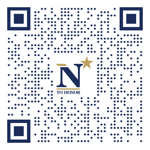
The "category" links below lead to lists of related Honorees; use them to explore further the service and sacrifice of alumni in Memorial Hall.
